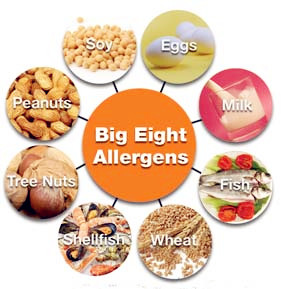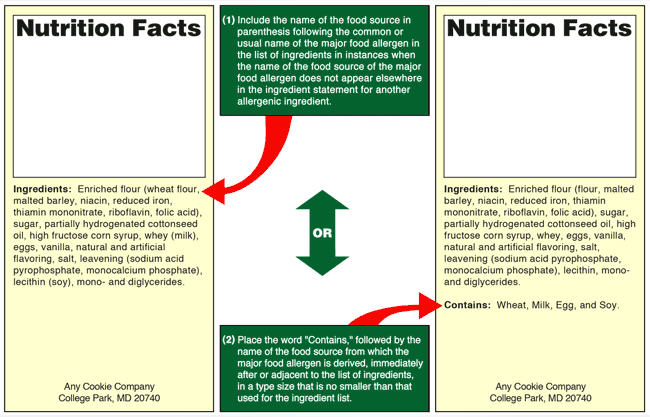Food Allergy
Your immune system is made up of soldiers and each one plays a different role in the war on invaders. One type of soldier are antibodies - and one of these is immunoglobulin E (IgE). Antibodies are signalers that catch invader particles and wave them around for the other immune cells to see (and destroy).
If you are allergic to a food, when you consume it, the offending food particles (antigens) are caught by their respective IgE molecule. This launches an attack by your immune system, leading to a variety of allergic reactions.
The Big Eight
flying with a peanut allergy?
The Food Allergen Labeling and Consumer Protection Act (FALCPA) requires food labels to clearly outline to consumers if their product contains one of the Big Eight. They have two options: Name out the food source in otherwise confusing ingredients names or place the phrase "Contains...(food source allergen)" underneath the ingredients list.
One thing to note is that companies may change the formulation of their product without issuing a public decree. If you or someone you grocery shop for has a food allergy, don't forget to check the label of the products you buy often because while the formulation may not be obvious, they will update the ingredient list according to FALCPA rules!
Food Intolerance
Remember when I said that food allergies are a response of the immune system? People have reactions to foods that researchers know aren't IgE-mediated. There's not as much research in this area, but more and more is coming out. What mainstream thought is that food intolerances occur in the digestive system (versus immune system) and occur when your body doesn't know how to break down a certain food correctly. This means that intact food particles make it to your colon (not supposed to happen) and instead of your body absorbing it, the bacteria in your large intestine eat it. And make gas. Hence the flatulence and bloating...and other not-so-fun gastrointestinal symptoms.
As a very brief overview of the more common intolerances, here we go! Food intolerances may happen when your body has trouble digesting lactose or gluten (wheat protein) or if you are sensitive to food additives and preservatives. Lactose and gluten intolerances typically cause gastrointestinal symptoms. Our culture consumes a large amount of processed foods which contain additives and preservatives. Some examples that might elicit some intolerance symptoms are benzoates, sulfites, BHT, and dyes. The FDA requires companies to label foods containing sulfites. Additives and preservatives typically elicit skin rashes as the response. So...
Do you get some discomfort from eating one of the Big Eight but you don't get any of the food allergy symptoms? Here's a quick 'quiz' to help you figure something out.
A clear difference between the two is that food allergies may be life-threatening while food tolerances (typically) are not!
If you feel you may have a food allergy, you can contact an allergist to help figure it out. For a more in depth view on the topic, you can read this article: http://www.worldallergy.org/professional/allergic_diseases_center/foodallergy/ Have you ever felt confused by your body's response to food? - Bailey
0 Comments
Your comment will be posted after it is approved.
Leave a Reply. |
a blog about health, wellness, nutrition, and fitness from an epidemiologist / dietitian with personal trainer experience
Stay up to date on productivity tips and active learning techniques
Like what you read?
categories
All
|







_250px.png)



 RSS Feed
RSS Feed
